Planning an outdoor event and worried about lighting? Harsh lights or deep shadows can ruin the mood. Adjustable LED floodlights give you the control to create the perfect atmosphere for success.
Adjustable LED floodlights offer unmatched flexibility for any outdoor event. You can change their brightness, color temperature, and beam angle. This lets you create a perfect, non-disruptive atmosphere for everything from concerts to weddings, all while saving significant energy.
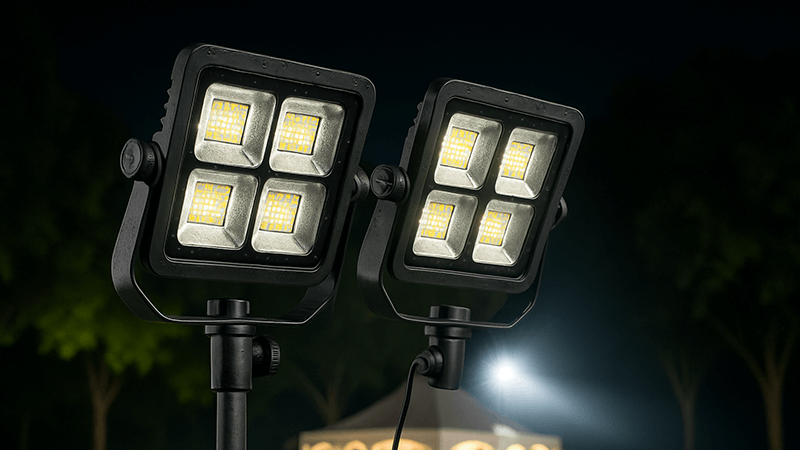
I’ve been in the lighting industry for a long time, and I’ve seen how the right light can completely transform a space. It’s not just about making things visible; it’s about creating an experience. An adjustable LED floodlight is the perfect tool for this. It becomes part of the environment, doing its job without drawing attention to itself. It gives you the power to set the exact mood you want. But to really use them well, you need to understand how they work and what makes them different. Let’s look closer at the details that matter for your projects.
How do adjustable LED lights work?
Do you find the technology behind adjustable lighting confusing? This uncertainty can make it hard to choose the right product. Understanding the core mechanics helps you make a confident, effective choice.
Adjustable LED lights work by using advanced drivers and control systems. These systems allow you to dim the brightness, change the color temperature from warm to cool, and sometimes even adjust the beam angle using special optics or swiveling mounts for precise light direction.
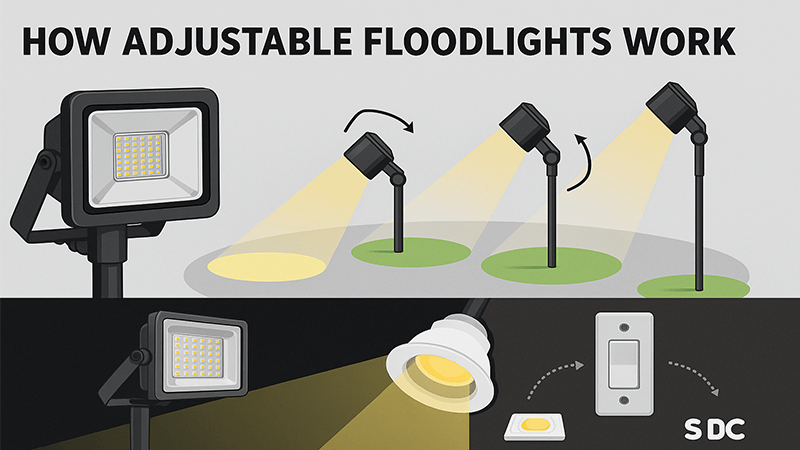
When a client like Shaz, a seasoned purchasing manager from the UAE, asks me how these lights offer so much control, I explain it by breaking it down into three key parts. It’s not magic; it’s just smart engineering that gives you complete command over your lighting environment. These components work together to deliver the flexibility that modern outdoor events demand. I’ve seen projects succeed or fail based on how well the lighting could adapt to different needs throughout an event. That’s why I always emphasize understanding the technology inside the fixture.
Brightness Control (Dimming)
The heart of brightness control is the LED driver. Think of it as the brain of the light. Standard drivers just turn the light on or off. Dimmable drivers, however, can carefully regulate the amount of electrical current flowing to the LED chips. By reducing the current, the LEDs produce less light, and by increasing it, they become brighter. This is often controlled through a signal, like a 0-10V signal or a wireless command, which tells the driver exactly how much power to supply. This gives you smooth, flicker-free dimming from 100% down to 10% or even lower.
Color Temperature Control (CCT Tuning)
To control color temperature, the fixture uses two sets of LED chips. One set produces a warm light (like a candle, around 2700K), and the other produces a cool, crisp light (like daylight, around 6500K). The control system lets you mix the output from these two sets. If you want a cozy, warm atmosphere, you power the warm white chips more. If you need a bright, alert environment for a task, you power the cool white chips more. By blending them in different ratios, you can achieve any color temperature in between, perfectly matching the mood of the event.
Angle and Direction Control
Adjusting the light’s direction is usually a mechanical feature. The fixture is mounted on a bracket, often called a yoke or a knuckle mount. This bracket allows the light to pivot up, down, left, or right. This is crucial for outdoor events because you need to aim the light precisely, whether you’re highlighting an architectural feature, illuminating a stage, or washing a wall with light. Some advanced models also have adjustable optics, where you can change the beam from a narrow spot to a wide flood. This combination of physical aiming and beam shaping gives you total control over where the light goes and how it spreads.
What is the best type of outdoor flood light?
Choosing the right flood light feels overwhelming with so many options. The wrong choice could mean poor performance and wasted money. You need a reliable light that fits your specific needs perfectly.
The best type of outdoor floodlight is an adjustable LED fixture with a high IP rating (IP65 or higher) for weatherproofing. Its ability to change brightness and color temperature makes it versatile for security, events, and architectural lighting, providing the most value and performance.
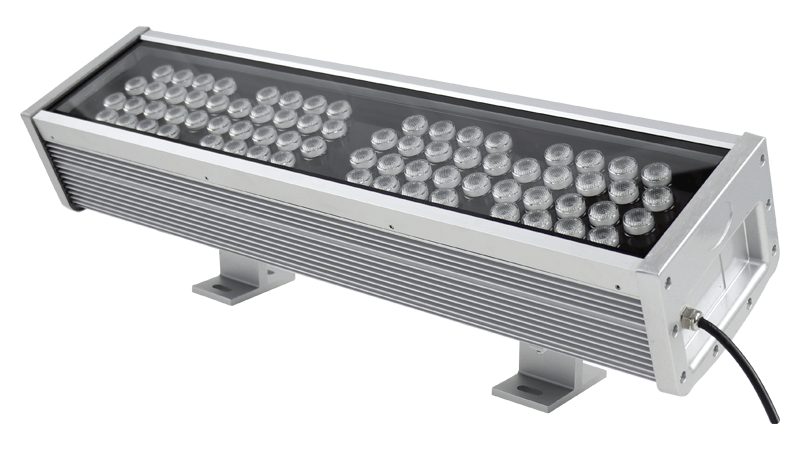
Over the years, I’ve helped countless partners select lighting. The conversation always comes back to the application. There is no single "best" floodlight for everyone, but there is always a best choice for a specific job. For a purchasing manager focusing on large-scale projects, the best light is one that can adapt to different scenarios. You don’t want to buy one type of light for building facades and another for event spaces. An adjustable LED floodlight covers all these bases. It simplifies purchasing and inventory while delivering superior results on the ground. Let’s compare the most common options to see why adjustability is the clear winner for professional use.
Comparing Outdoor Flood Light Types
| Feature |
Adjustable LED Floodlight |
Standard LED Floodlight |
Halogen Floodlight |
| Flexibility |
Excellent (Dimming, CCT, Angle) |
Poor (Fixed output) |
Poor (Fixed output) |
| Energy Efficiency |
Excellent |
Good |
Poor |
| Lifespan |
50,000+ hours |
50,000+ hours |
~2,000 hours |
| Durability |
High (Solid-state, IP65+) |
High (Solid-state, IP65+) |
Low (Fragile filament) |
| Heat Output |
Low |
Low |
Very High |
| Best For |
Multi-purpose professional use |
Basic security/area lighting |
Temporary, low-cost needs |
Why Versatility Matters Most
For projects, versatility is key. Think about an outdoor venue: one night, it’s hosting a corporate gala that needs warm, subtle lighting. The next night, it’s a concert that requires bright, cool light on the stage. With a standard, fixed floodlight, you can’t meet both needs effectively. You would compromise on the atmosphere. With an adjustable LED floodlight, a simple command changes the entire feel of the space. This is the advantage I always highlight. It gives the end-user, the event planner, or the property manager the power to get the lighting exactly right every single time. This adaptability makes it the smartest long-term investment.
What is the difference between LED light and LED flood light?
Are you unsure about the specific terms "LED light" and "LED flood light"? This confusion can lead to ordering the wrong product. Knowing the precise difference ensures you get exactly what you need.
"LED light" is a general term for any light source using LED technology. An "LED floodlight" is a specific type of fixture that uses LEDs to produce a very broad beam of high-intensity light, designed to illuminate large outdoor areas.
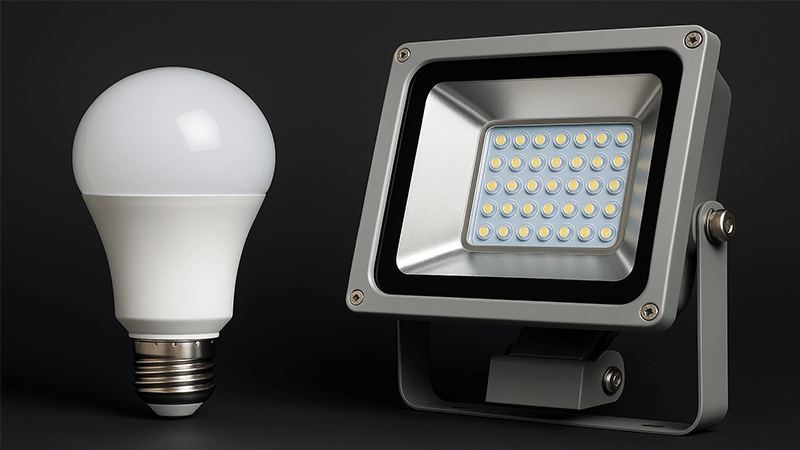
This is a question I get a lot, especially from new buyers entering the industry. It’s a simple but important distinction. I always tell them to think of it like the word "vehicle" versus the word "truck." One is the general category, and the other is a specific tool designed for a heavy-duty job. All floodlights today might be LED lights, but not all LED lights are floodlights. For a project that requires illuminating a parking lot, a building facade, or a sports field, you don’t just need an LED light; you specifically need an LED floodlight. The design, optics, and power are all engineered for that one purpose: to flood an area with light.
Defining the Terms
To make it crystal clear, let’s break it down further.
LED Light
This is the technology itself. It refers to any lamp or fixture that uses a light-emitting diode (LED) to create light. This is an incredibly broad category that includes many different products designed for different jobs.
- Examples:
- The lightbulb in your desk lamp (A-type bulb)
- The tube lights in an office (T8 tubes)
- The strip lights under a kitchen cabinet
- The spotlight in an art gallery
- Key Characteristic: The term describes the light source, not its application or beam pattern.
LED Floodlight
This is a specific type of lighting fixture built for a purpose. It uses powerful LED arrays and is designed to project a wide beam of light over a large area. The name "flood" perfectly describes its function—it floods a space with illumination.
- Key Characteristics:
- High Lumen Output: They are very bright to cover large distances.
- Wide Beam Angle: Typically 90 to 120 degrees to spread light broadly.
- Durable Housing: Built to withstand outdoor weather conditions (e.g., rain, dust, heat) with high IP ratings.
- Common Applications: Lighting up building exteriors, sports fields, parking lots, construction sites, and event spaces.
In my factory, we produce many kinds of LED lights, but the engineering for an LED floodlight is specialized. We focus on thermal management to handle the heat from the powerful LEDs, we use robust seals to ensure weatherproofing, and we design strong mounting brackets to hold the fixture securely in place. It’s a tool built for power and endurance.
What is the negative side of the LED light?
Are you wondering if LED lights have any downsides? Believing they are perfect can lead to unexpected issues. Knowing their limitations helps you plan better and avoid potential problems on your projects.
The main negative side of LED lights is their higher initial cost compared to older technologies. They are also sensitive to high heat, which can reduce their lifespan, and some cheaper models can produce glare or flicker, causing eye discomfort.
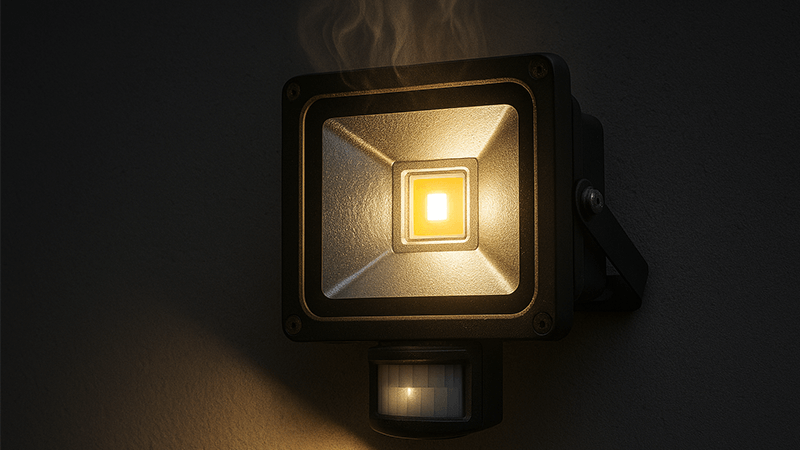
As a manufacturer, honesty about my products is critical. I’ve built my brand, iPHD, on quality, and that means acknowledging the challenges as well as the benefits. While LEDs are an amazing technology, they are not flawless. I always advise partners like Shaz to look beyond the marketing and understand the potential trade-offs. The biggest issues—cost, heat, and quality—are all manageable, but only if you are aware of them from the start. Ignoring them to save a few dollars on the initial purchase almost always leads to bigger problems and more expenses later on.
Key Challenges and How to Address Them
Let’s look at the main disadvantages and discuss the practical solutions. I believe in tackling problems head-on, and in manufacturing, that means solving them with better design and quality control.
1. Higher Upfront Cost
LED floodlights, especially high-quality adjustable models, cost more to buy than old halogen or metal halide fixtures. This initial investment can be a barrier for some projects with tight budgets.
- My Solution: I always frame this in terms of Total Cost of Ownership (TCO). Yes, the initial price is higher, but the savings are enormous. LEDs use up to 80% less energy and last over 25 times longer than halogen bulbs. This means drastically lower electricity bills and almost zero maintenance or replacement costs. Over the full life of the fixture, LEDs are by far the cheaper option.
2. Sensitivity to Heat
This is the biggest enemy of an LED. The electronic components inside are sensitive to high temperatures. If a fixture is poorly designed without proper heat dissipation, the heat generated by the LEDs themselves will get trapped. This can cause the light output to decrease permanently and significantly shorten the fixture’s lifespan.
- My Solution: This is where quality manufacturing makes all the difference. At my company, we focus heavily on thermal management. We use high-grade aluminum for the fixture housing and design it with large fins to act as a heat sink. This draws heat away from the sensitive LED chips and driver, ensuring the light performs reliably for its full 50,000-hour rated life, even in hot climates like the UAE.
3. Inconsistent Quality and Glare
The market is flooded with low-cost LED products. Many of these are made with cheap components, poor assembly, and no real quality control. These lights can flicker, have inconsistent color, and produce uncomfortable, harsh glare. This not only looks unprofessional but can also cause eye strain and headaches.
- My Solution: We solve this by controlling the entire process. We source high-quality LED chips from reputable brands and use advanced drivers that provide clean, stable power to prevent flicker. For glare, it’s all about the optics. We design our lenses and reflectors to shape the light beam effectively, directing it where it’s needed without spilling into people’s eyes. Investing in a quality product from a reliable manufacturer like Upward Lighting is the only way to avoid these issues.
Conclusion
Adjustable LED floodlights give you total control over brightness, color, and angle. This flexibility ensures perfect, non-disruptive lighting for any outdoor event, making them the superior and most versatile choice.